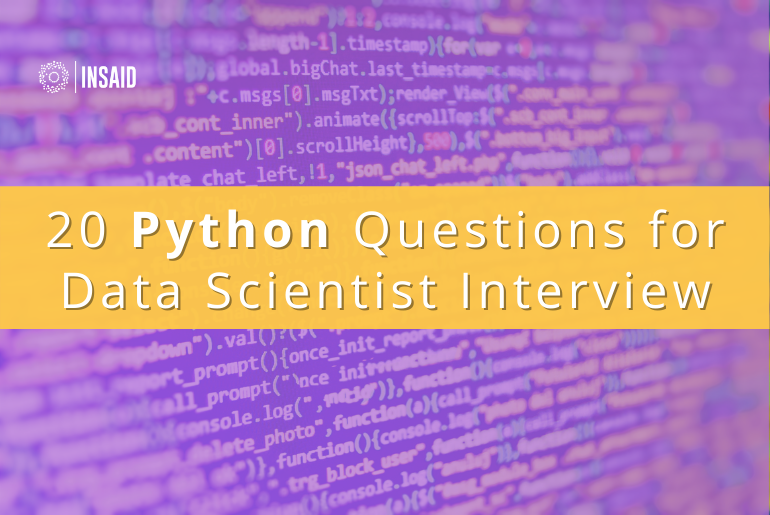With its easy-to-follow syntax, a countless number of libraries and built-in data types – Python has emerged as the defacto choice of Data Scientists today. As per TIOBE Index, as of August 2021, Python is the second most popular programming language across the world. From startups to tech giants, companies are actively using python for data science, analysis, and data engineering.
So, if you’re applying for a Data Scientist role, it’s crucial to have strong Python skills. And the best way to master Python for Data Scientist interviews is to practice questions. In this article, we cover 20 Python questions that will help you crack Data Scientist interview. This list covers questions on Python basics for Data Science along with advanced programming. Let’s start practicing.
Basic Python Questions for Data Scientist Interview
1. Name the data types used in Python?
The Python built-in data types include:
- Numeric (int, float)
- Text or String (str)
- Tuple (tuple)
- List (list)
- Set (set)
- Dictionary (dict)
- Boolean (bool)
2. Define a Dictionary in Python
A dictionary is defined as a collection of mutable and indexed data points. Dictionaries are written in curly braces with key: value pairs.

3. What is the use of comprehensions in Python?
Comprehensions provide a concise way to create new lists using pre-defined sequences.

4. What do you understand by negative index in Python?
A negative index is used to index an array, list, or string. A negative index of -1 gives the last element, -2 gives the second last element, and so on.

5. What are strings in python?
A string in python is defined as a sequence of characters or words. It can be represented using single, double, and triple quotes.
6. What is the use of the range () function in python?
The range function is used to iterate over a sequence of numbers. It generates arithmetic progressions.

7. What is a Python library? Give a few examples
A python library is a collection of python packages. Some commonly used python libraries include Numpy, Pandas, Matplotlib, and Scikit-learn.
8. How to import libraries in python?
Libraries can be imported in three ways:

9. Write the code to create a random 1D array using NumPy.

10. Using pandas, write python code to create customers DataFrame from the “bank.csv” file.

Advanced Python Questions for Data Scientist Interview
11. Explain loop interruption statements in python.
The two types of loop interruption statements include break and continue. These statements are used to terminate a loop before it completes its full iterations.
- Break: It immediately terminates the entire loop, and control of the program is shifted outside of the loop.
- Continue: It ceases the current loop and the control of the program is shifted to the following iteration.
12. How can you generate random numbers in Python?
A random module is used to generate random numbers in Python. It is defined as:

13. How to add values to a python array?
Values can be added to a python array with the help of the append(), extend() and insert (i,x) functions.

14. How are classes created in Python?
Class in Python is created using the class keyword.

15. Describe the use of ‘is’, ‘not’, and ‘in’ operators?
- Is function returns true when 2 operands are true
- The not function returns the inverse of the boolean value
- The in function checks if some element is present in the sequence
16. Which function is used to convert a string to all lowercase?
To convert a string to lowercase, the lower() function is used.

17. How would you get a list of all the keys in a Dictionary?
To obtain a list of all the keys in a dictionary, we use function keys():

18. What is the use of FOR loop in python?
For Loop in python is used to iterate through the elements of an array. It can also be used to perform any fixed number of repetitions and by a given (positive or negative) increment. However, the increment by default is always by one.
19. How is a global variable different from a local variable?
A variable that is proclaimed outside a function is referred to as a global variable. On the other hand, a variable declared inside a function is called a local variable.

20. Why is the help() and dir() function used in Python?
- The help() function is primarily used to display the documentation string.
- On the other hand, the dir() function is used to unveil defined symbols.
If you are applying for a Data Scientist role, in addition to practicing python questions, it is important to cover other topics as well. One such important topic is SQL. We recommend you practice these 15 SQL questions for your next Data Scientist interview. These questions will help you brush up on your Data Science skills, practice, and prepare for the interview.
 Pin
PinWe hope you found this article useful. If you want us to cover more Python questions for the Data Scientist interview, let us know in the comments below.







Thanks for sharing this valuable information. I agree with your points and your ideas. we appreciate your thoughts.